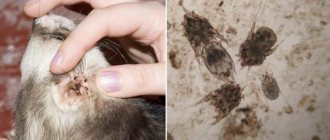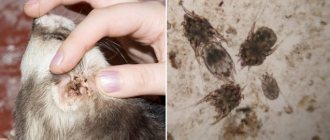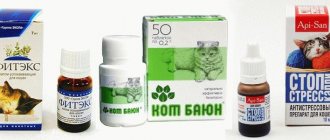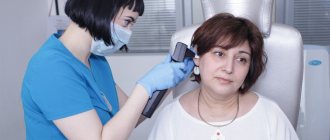Ringworm in cats is a fungal infection of an animal. What is the cause of the disease? In the first place is infection. Reduced immunity, allergies, and viruses are also prerequisites for the disease. More recently, 20 years ago, even 10 years ago, the disease was considered incurable. Pets were euthanized. Fortunately, today lichen in cats and kittens can be treated. The disease is contagious; it can infect other animals and, which is very unpleasant, people.
It is necessary to be vigilant and at the first signs of deprivation (we will talk about them a little later) not to self-medicate, but, having grabbed your pet, come to an appointment with a veterinarian for an accurate diagnosis. Many people encounter this for the first time, panic, search on forums, ask friends what to do? Yes, you can listen to advice, but! you should calm down and come with your cat to a doctor's consultation. By being patient and receiving the necessary treatment methods, you can help your pet recover.
In the article we will talk about the types of ringworm, its symptoms, and will dwell in more detail on the treatment of ringworm and prevention.
Types of lichen
There are several types of lichen. They differ not only in external signs, but are also treated differently.
- Lichen planus;
- Pink or herpes zoster;
- Ringworm or eczema;
- Pityriasis versicolor;
- Ringworm.
Lichen planus is characterized by the appearance of red blisters on the cat's skin. It itches constantly, the blisters burst, causing severe itching. Red bubbles appear in the groin, abdomen, and on the bends of the joints. The mucous membranes are affected. This type of lichen in a cat signals that not everything is ok with the immune system. The good news is that this shingles is not spread to other animals or people.
Pityriasis rosea in a cat is a sign of a viral infection. How does it manifest itself? Pink spots ranging in size from 1.5 to 2 cm appear on the animal’s body. The cat itches and the skin peels off. Then the stain becomes crusty. Ringworm usually goes away on its own. During the period of exacerbation, the animal should not be washed or released into the sun. You need to take care of his healthy diet. There is no consensus in the scientific world about whether pityriasis rosea in cats is dangerous or not.
With weeping lichen, red bubbles appear, filled with liquid, which are very painful. Ringworm or eczema is rare. The disease can be caused by a malfunction in the immune system, the presence of parasites, allergies to food and detergents. This type of lichen is not contagious.
Let's look at what pityriasis versicolor (varicolored) lichen in cats is. This type of lichen is very contagious for humans and is easily transmitted to other animals. It is also called “sun fungus” and “beach lichen”. Oval spots of pink, brown, pale yellow color appear on your pet's body, growing very quickly. Pityriasis versicolor requires long-term and serious treatment.
Diagnostics
The presence of even all the symptoms of feline lichen does not provide a 100% guarantee of diagnosing dermatophytosis. These may be signs of decreased immunity or vitamin deficiency. Therefore, veterinarians take samples of fungi from fur and skin, and diagnose lichen from the affected areas using laboratory testing. This is a simple and effective method that any veterinarian can do.
Another method is a Wood's lamp. The cat is exposed to the light of a lamp; harmful fungal spores that cause lichen glow with fluorescent light. The effectiveness of the method is only 60%. Since it is not possible to illuminate the entire body, the light exposes fungal spores that cause other diseases.
Ringworm
Now let’s take a closer look at what ringworm is in a cat. It is one of the most dangerous and common types of lichen. What is the danger and insidiousness of this disease? The fact is that the incubation period for lichen in cats can last from several days to several months. Other animals and unsuspecting people become infected. It is especially dangerous for long-haired breeds, since the hair prevents the first signs of the disease from being seen. How to treat ringworm in cats will be discussed a little later.
Let's consider what is the causative agent of ringworm? These are dermatophyte molds. There are two forms of ringworm:
- - microsporia;
- - trichyphytosis.
- What happens with microsporia?
- - hair fragility appears at the skin level;
- - wool hair is easily pulled out.
When hair falls out, other animals and people become infected with fungal spores.
Trichophytosis, the second form of the fungus, is very rare. With this type of ringworm, baldness appears only in the head and neck area.
There are three forms of the disease:
- -superficial;
- -deep;
- -atypical.
With a superficial and atypical form of ringworm in cats, for a long time it is impossible to notice that the disease process has already begun.
It is very important to identify the disease at an early stage; the method and time of treatment for your pet will depend on this.
Who is at risk and can get ringworm?
- -most often these are small kittens;
- - long-haired breeds (genetically predisposed to such diseases);
- - cats with malignant processes in the body;
- - cats infected with parasites;
- -young cats up to one year of age.
One of the most pressing and exciting questions is how is lichen transmitted from cats? Unfortunately, ringworm is contagious to humans. You love your pet, pet it, pick it up. Yes, usually upon contact the process of lichen infection occurs. This happens especially easily if there are scratches, wounds, or abrasions on your hands. You can become infected by dandruff, scales, and hair falling from a cat. Children can become infected very easily while playing in the sandbox. Your home, bowls, rugs, combs, etc. are contaminated. Fungal spores are very stable and viable. Will the person get sick or not? It depends on the type of lichen and the person’s immunity. Children and people with weakened immune systems are at risk.
Signs and symptoms
The incubation period of the disease is almost 3 months, so symptoms may not appear immediately. At the initial stage, it is almost impossible to recognize the first signs and determine lichen in a cat, but already at this stage the pet becomes infectious to the people and animals around it.
The main symptoms of ringworm in cats:
- deterioration in the condition of the coat is expressed in its breaking off, dullness and greasy;
- in some places bald spots appear, on which broken hairs are visible, gradually this area becomes more bare;
- bald areas become pink (less often gray-brown) and begin to become covered with scales and crusts;
- the animal loses its appetite, becomes lethargic and apathetic;
- due to constant itching, the cat begins to actively itch and bleeding scratches appear;
- when the claws are damaged, they become deformed;
- Over time, blisters may appear on the surface of the epidermis, which become covered with crusts, and if a secondary infection occurs, ulcers may appear.
The degree of damage to the skin and fur manifests itself depending on the state of health and immunity of the animal: in a healthy cat, only 1-2 spots are possible, in a weakened cat, lichen covers large areas of the body. The most commonly affected areas are the head, neck, muzzle, ears, back, tail and paws in the claw area.
How to avoid getting shingles from a cat?
Firstly, do not have contact with stray animals and do not allow children to do this. After walking, be sure to wash your hands. If you have a cat, take it to the vet to have it checked for ringworm. Clean the apartment regularly using disinfectants. Be sure to treat your cat for parasites. It is important to provide your pet with a nutritious diet; this helps maintain its good condition, increases immunity, and therefore the skin’s resistance to infections.
Now let’s look at where cats get lichen from? Your pet can become infected through contact with a sick animal. And even without communicating with one, yours can become infected simply by walking in the country. Ringworm spores can be found on the soil. Sometimes you yourself are the cause of your absolutely domestic furry's illness. The fact is that you can bring fungus into your home on clothes, shoes, and things. Sometimes small children infect their pets. The child stroked a cute cat on the street and, when he came home, stroked his own. And that’s it, contact happened.
What can be observed with all types of lichen in cats:
- - hair falls out;
- - the skin becomes inflamed and peels;
- - areas of the skin become inflamed;
- - severe itching appears;
Can other animals become infected?
This easily transmitted disease is spread by fungal spores that can affect any mammals, which include dogs, cats, and rodents. Animals that live outdoors are at greatest risk.
When one infected pet appears, everyone around them is at risk of getting sick. The infection may quickly spread among residents of shelters or cat and dog kennels. Therefore, it is so important for the owner to isolate the sick animal from people and other pets.
How to identify ringworm in a cat at home?
- -one of the first signs that should alert you is that the cat scratches itself often, eats poorly, and does not behave as usual. What happens, what should you pay attention to, how does lichen begin in cats?
- - round flaky spots appear. In some cases, spots appear all over the body. Ringworm often appears in cats on the ears, paws, and face. It all depends on the specific pathogen;
- - crusts form at the spots;
- - hair falls out;
- - your cat itches a lot, often chews and scratches spots;
- - scabs appear along the spine;
- -spots expand and take on an oval shape;
- - in places where the rash appears, the hair thins and the hairs become sparse;
- - the spots grow, if treatment is not started, your pupil will die.
Briefly about the atypical form of ringworm. The fact is that the signs of lichen described above in this form of the disease are absent or not clearly expressed. The disease proceeds unnoticed, since only individual hairs are affected. This is the danger of this disease. The owner does not suspect anything, since he does not see signs of infection, does not take any measures for a long time, and the disease develops.
How to make the correct diagnosis for lichen?
Diagnosis of lichen, due to its diverse manifestations, is only possible using laboratory methods. Based on clinical signs, lichen can only be suspected.
Methods for diagnosing lichen:
- Wood's lamp examination - microsporia gives a greenish glow, trichophytosis may not be detected;
- Microscopy of affected hair - spores are detected in 70% of cases;
- Sowing samples on nutrient media followed by microscopy of the grown fungus is the most reliable, but time-consuming (up to 2 weeks) method.
The veterinarian will select the necessary diagnostic method.
How to determine if a cat has lichen or not?
If you suspect that something is wrong with your cat, do not delay visiting the veterinarian. This will save your time, nerves, and money on treatment. Skin diseases are mostly similar to each other. Even an experienced specialist will not be able to determine by eye what is wrong with your animal? To determine an accurate diagnosis, there are methods such as instrumental and laboratory tests. Using these methods, it is determined that your pet has allergic dermatitis or contagious ringworm.
Initially, the doctor examines your cat, interviews you, if there is a medical record, studies it. Then, after the examination, the examination begins.
- Your pet is scanned under a Wood's fluorescent lamp. Under a Wood's lamp, a cat's lichen glows green. This method is not accurate, because harmless microbes can glow and, conversely, pathogenic microbes do not glow.
- The next method is to scrape the skin or affected hair and examine it under a microscope. It's called trichoscopy. The result is also fast, but not one hundred percent. It is not always possible to detect a fungal infection, but this does not mean that the disease does not exist.
- Sowing a culture of a pathogenic fungus in a nutrient medium is the most accurate and reliable way to determine lichen. To do this, collect the crust and scales, which are placed in a Petri dish. After a certain time (you need to wait about three weeks to get the result), a diagnosis is made. This method is used if the disease has not been cured for a long time. The analysis helps you choose the right medications to cure your cat of lichen.
- Additionally, a blood test is taken. They examine whether your pet has chronic diseases and determine the presence of parasites.
You can undergo treatment in a clinic or at home. Most cats are treated by the owners themselves. How to treat lichen in a cat at home? Follow all the veterinarian's instructions; do not interrupt the course of treatment if you think that everything is already in order. Consult your doctor about what to feed your cat. Mandatory treatment of your home, this will be discussed further.
Is it possible to give antibiotics?
Treatment of lichen in cats at home with antibiotics is necessary when a secondary infection occurs. This does not mean that the animal needs to be given antibacterial drugs in tablets. Taking oral antibiotics will only lead to a decrease in immunity, which is necessary to fight the fungus.
For lichen, the veterinarian can only prescribe topical antibiotics. This is necessary if the animal’s lichen rashes are complicated by an inflammatory process or the appearance of pustules. This often occurs when scratching the affected areas and introducing bacteria into the skin.
Most often, cats are prescribed the following antibacterial ointments for lichen:
- "Tetracycline ointment";
- "Syntomycin ointment";
- "Levomekol";
- "Streptomycin".
It is important to remember that antibiotic-based ointments do not affect the causative agent of lichen. They are only effective against secondary bacterial infection.
How to remove lichen from a cat?
Treatment by a professional is the most correct and reliable method of treatment. There are also folk remedies. More on them later.
Treatment for ringworm in cats depends on the severity of the disease, the breed of the cat, its age, immunity, the presence of chronic diseases, and pregnancy. During treatment, different drugs are used. For local treatment - these are ointments, creams, sprays, drops, shampoos. For severe cases of the disease, tablets, vitamins and immunomodulators are prescribed. Vaccines are also used. Now let's look at some of the drugs used in treatment.
For example, Clotrimazole for lichen in cats. During the initial treatment of deprivation in a cat with Clotrimazole, the veterinarian gives her an injection and treats the infected areas with the drug. The product is available in the form of gels, solutions, creams, tablets, and injections. It is found on sale as Candizol, Amyclone and Fungin.
Veterinarians advise cat owners to have Clotrimazole ointment in their home medicine cabinet; they also use it for inflammatory processes. Scheme for treating ringworm in an animal with Clotrimazole ointment: lubricate the infected areas with ointment two to three times a day, applying a thin layer, gently rubbing. Do it within a week. Repeat after three to four weeks, lubricate once or twice a day. What to do if the areas are very large? First, wash the affected area with soap and water and dry. Then apply Clotrimazole ointment three to four times daily for three to four weeks.
Terbinafine, a broad-spectrum drug, is also used to treat ringworm in cats. Available in tablets, ointments, creams. Terbinafine ointment is applied in a thin layer to the infected areas once or twice a day. During healing, crusts form on the wounds, which must be removed with a cotton pad moistened with water.
The healing process can last 30 days or more. It all depends on the severity of the disease and the fungus. Very important: do not self-medicate! Anti-lichen tablets for cats are prescribed only by a specialist when the disease is severe, as they have side effects. The doctor prescribes the dosage and regimen of medications.
Now about the vaccine. Abroad (in Europe and America), the lichen vaccine is not used for cats. In Russia, the lichen vaccine for cats is used for both treatment and vaccination. The most common of them:
- Vakderm;
- -Microderm;
- -Polivak TM.
What does the shingles vaccination give? This is an opportunity to protect the animal from infection for a long time. The following must be taken into account:
- -Vaccination from the age of two months;
- -Contraindications – cat pregnancy;
- -The cat must be healthy. If she was sick, then the vaccine can be done after two or even three weeks;
- -10-14 days before the lichen vaccination, you must give an anti-worm tablet. To get rid of skin parasites, bathe your cat with a special shampoo.
- - Conduct a diagnosis for ringworm under a Wood's lamp.
Animals usually tolerate lichen vaccination easily.
There is an opinion that vaccination against lichen is not necessary for cats. Whether to do it or not, you decide for yourself.
The main means of combating ringworm in cats remain antifungal drugs and mandatory hygiene.
Ringworm shampoo for cats must be used in the treatment of the disease. These are special shampoos containing Miconazole, Ketocanazole, Epilconazole. They are usually used twice a week for 5-6 weeks. The most popular of them are Nizoral and Sebozol. You cannot cure your cat of ringworm using shampoo alone. They are used only in complex therapy.
Sulfur ringworm ointment is also used to treat cats. Apply to the affected area, covering another 2-3 cm around 1-2 times a day for a week.
YAM BK ointment is often used in the treatment of lichen in cats. The affected area is treated, covering another 2-3 cm nearby 1-2 times a day. Using a cotton swab or swab, gently rub in the ointment twice a day. Treatment time is from 4 to 10 days.
Reviews about the use of potassium permanganate against lichen in cats differ. Some people find the use of potassium permanganate effective. Yes, in the case of ringworm, the use of potassium permanganate is justified. If an animal has pityriasis rosea, the use of potassium permanganate is prohibited, as it can provoke the appearance of eczema. Wash the wounds with a weak solution of potassium permanganate and lubricate the sores. When treating ringworm in cats, a solution of potassium permanganate and a solution of hydrogen peroxide are often combined. First, drop potassium permanganate and then a drop of peroxide. The procedure is safe and effective.
Ringworm spray for cats is the most convenient remedy used for external treatment of cats against lichen. It is applied to sore spots, lightly rubbing. Repeat 2-3 times a day.
When treating cats with lichen using external means, they must wear a protective collar made in the form of a mouthpiece. Many products are toxic, and this will prevent the animal from licking them.
Quite conflicting opinions exist about the treatment of lichen in cats with iodine. Just look at the forum and read the reviews. Can lichen be treated with iodine? Some argue that it is possible. Others categorically deny. Based on the first statement: it can be cured at the initial stage by lubricating small affected areas 2 times a day. Why not? Iodine causes skin burns.
Treatment with drugs
Treatment of lichen is carried out comprehensively and systematically using the following anti-lichen drugs prescribed by a veterinarian:
- Vaccines for the treatment of ringworm (trichopytosis and microsporia) - Vakderm F, Polivac TM, which are administered intramuscularly in the area of the femoral muscle 1-2 times with an interval of 2 weeks. Used at the initial stage of the disease.
- Ointments with antimycotic action. Used for local treatment.
- Special shampoos with antifungal ingredients (Nizoral with ketoconazole, Doctor skin shampoo, Antiseptic & Antifungal vet shampoo). They are an addition to the main course of treatment, because help reduce itching, have a positive effect on the skin and speed up recovery. Before use, the area around the affected area must be shaved and treated with an antiseptic.
- Sprays for animals (Fungin, Vakderm, Mycostop Provet). Medicines containing clotrimazole, which are applied to the affected area, the course is 1-2 weeks.
When choosing medications for complex therapy, the veterinarian takes into account several factors:
- the size and number of affected areas on the pet’s skin;
- severity of the disease and general condition of the animal;
- state of immunity.
You should know that antifungal drugs should be used in quantities of no more than 2 types and forms, so that the active ingredients do not accumulate in the animal’s body, because this can lead to toxic poisoning.
Folk remedies for treating lichen.
There are also folk remedies for the treatment of ringworm in cats. This is especially true for healing pregnant cats, since many drugs used in treatment are harmful to them and their offspring. The most popular of them:
- -warm mixture of aloe juice and olive oil (1:1 ratio). Lubricate the affected areas;
- - treat with iodine solution twice a day;
- - treat wounds with celandine;
- -sprinkle the infected areas with newspaper ash 3-4 times a day;
- – mix lemon juice and olive oil in equal doses and apply warm to sore spots four times a day;
- - decoctions of herbs from valerian, chamomile, burdock, plantain, yarrow, tricolor violet, etc. are used. Herbs are used in combination or separately.
Remember: it is impossible to cure lichen in a cat with folk remedies, since it is a fungal disease. Ointments and preparations are available both in price and in their availability. For treatment to be effective, you must follow all the veterinarian’s instructions.
Antiseptics
Before applying antifungal agents, it is necessary to treat your pet's skin with antiseptics. When treating lichen in cats at home, alcohol solutions of iodine and brilliant green should not be used. These products can cause burns and, in some cases, a severe allergic reaction.
The need to use antiseptics is due to the fact that cats experience severe itching and often scratch their skin. This can lead to bacterial complications of lichen and significantly complicate treatment.
Veterinarians recommend using the following antiseptics to treat ringworm in cats at home:
- "Salicylic alcohol". This antiseptic destroys both bacteria and fungal colonies. It inhibits the formation of proteins in the spores of the causative agent of lichen. Clean the skin with alcohol twice or thrice a day before applying topical antifungal agents.
- "Fukortsin". This is a red solution that has antibacterial and antifungal properties. The drug consists of a mixture of several antiseptic substances. After using Fukortsin, it is necessary to monitor the animal’s condition. The drug contains phenol; this component can cause lethargy and drowsiness in animals.
If the skin already has scratches and scratches, then the affected areas are treated with hydrogen peroxide or furatsilin solution. These antiseptics have predominantly antibacterial properties. They will help avoid the appearance of inflammation and pustules.
What to do if your cat has shingles?
- -After the diagnosis has been established and treatment prescribed by a veterinarian, it is necessary to treat your home. It is very good if the animal can be isolated, which is not always possible. No contact with children!
- -Treat a sick pet on special bedding (ideally disposable), wearing disposable gloves and protective clothing. After the procedure, disinfect things.
- – In the house, treat not only the floors, but also the doors, baseboards, corners, cracks, cabinet and upholstered furniture. Carry out wet cleaning with the addition of disinfectants.
- -Wash bed linen regularly.
- – Vacuum the room using disposable bags – dust collectors.
There are a lot of chemical solutions for effective surface treatment, but given their high cost, not everyone can buy them. You can use available tools:
- -A solution of bleach with water in a ratio of 1:10. They wash floors with it.
- -A saturated solution of laundry soap (1:6), also for washing the floor.
- -Solution of medical ethyl alcohol 96% with water (1:10). They treat all surfaces except upholstered furniture. Upholstered furniture is vacuumed.
Preventive measures
Prevention of ringworm is based on regular medical examinations of children attending preschool educational institutions. Parents should talk to their children about the inadmissibility of contact with stray animals. An important preventive measure is compliance with personal hygiene rules by patients of all age groups.
When purchasing pets, you must visit a veterinarian. The doctor will examine the cat or dog and give recommendations on how to eliminate any health problems with the pet. Following your veterinarian's advice will help prevent microscopic outbreaks within your family.
Symptoms of lichen in humans from cats
As mentioned above, ringworm is contagious to humans. Children are infected first, then people with weakened immune systems and allergy sufferers. What happens to a person infected with lichen from a cat?
After infection, the disease may appear from several days to several weeks. Ringworm can appear on the body, nails, and head. Peeling spots appear on the skin, spots grow, and the skin turns red. Round, flaky bald spots appear on the head (the area looks as if someone has shaved it), and grayish spots appear on the nails, which leads to their fragility. Unlike cats, lichen in humans generally occurs without complications. If you discover suspicious, unknown skin diseases, immediately go to a dermatologist.
Causes
Fungal spores are very tenacious and small in size. Therefore, it is very easy to become infected with lichen. Most stray cats are infected with this disease. If a domestic pet comes into contact with its wild relatives, then infection occurs in almost 100% of cases.
Even cats that never go for walks often become infected with lichen. Pet owners can bring fungal spores into the house on shoes or clothes. Most often, weakened cats with reduced immunity get lichen. Long-haired breeds are especially susceptible to fungal infections.
Prevention of lichen in cats.
- -First of all, it’s cleanliness. Regularly wash and treat your cat's care items with antifungal agents, and change bedding periodically.
- -Bathe your pet in baths with special shampoos.
- -Pay attention to the condition of his skin.
- – Treat your home with disinfectants.
- -Limit, or better yet eliminate, contact with other animals.
- -Provide your pet with a balanced diet, including vitamins, to strengthen the immune system.
- -Show your cat to the veterinarian periodically.
If you are reading this article, then you are faced with this unpleasant disease. Don’t despair, help your pet, because her life and health are in your hands. Do not self-medicate. Follow all instructions from your veterinarian. Only you can cure your pet of lichen.
How to avoid infection
Due to the fact that the nature of the occurrence of Gibert's disease has not been thoroughly studied, there are no methods to prevent this disease. The main recommendation is to monitor the state of the immune system, as it will help avoid infection.
Complications
The disease itself in most cases goes away without leaving a trace. However, sometimes complications arise in the form of eczema, staphylococcus or streptococcus; ring-shaped lichen can develop, which quite often becomes chronic and even after a few years a relapse can occur. Then treatment is done with antibiotics. To prevent such problems, we strongly recommend that you undergo comprehensive treatment in our clinic. Don't forget about your health and the health of your family!










